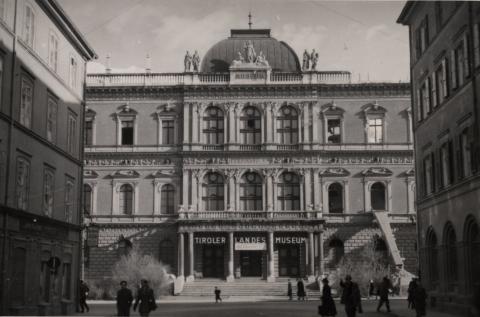The Tiroler Landesmuseum Ferdinandeum owes its name to Archduke Ferdinand Karl, the future Emperor Ferdinand I (1793–1875), under whose protection the museum association, which is still private today, was founded in 1823. In the 1840s the building at Museumstraße 15 in Innsbruck was constructed and steadily enlarged in the following decades. Significant roles in the shaping of the museum have been played in its history not only by the director but also by the board of the association and the committee members. The Ferdinandeum generally acquired objects itself but regularly received artworks on loan that had been purchased by the Tyrol provincial government or the city of Innsbruck. The collections were often supplemented as well by private gifts or legacies. The museum has seven sections: a special library for Tyrolean geography, architecture, history of art, graphic art, history, science and music.
The association's financial situation took a turn for the worse in the 1930s. During the Nazi era, the museum's affairs were managed by Oswald Trapp, who was elected chairman of the museum association in 1937. Trapp had also been Landeskonservator of Tyrol since 1934. Vinzenz Oberhammer became director of the museum in 1938. The first committee meeting after the annexation of Austria to the German Reich took place on 12 April 1938. Two of the sixteen committee members were members of the NSDAP, and Richard Heuberger, professor of medieval history at the University of Innsbruck (NSDAP membership no. 6 228 310), became provisional director of the Tiroler Landesmuseum. On 10 May 1938, Trapp, although regarded as politically unreliable, was appointed first authorized agent of the provisional director. While Heuberger remained provisional director until the end of the war, Trapp took care of the board's business until 1943 before being succeeded by Kunibert Zimmeter. The first ordinary meeting of the museum association in eight years took place on 16 July 1945, following instructions by the Tyrol police headquarters to elect a new board.
The Ferdinandeum hoped in 1939 to acquire objects from seized collections. Oberhammer, who was responsible for the selection of items, sent a detailed wish list in January 1940 to the Zentralstelle für Denkmalschutz (Central Monument Protection Authority) and to Hans Posse, "special representative" for the "Linzer Kunstmuseum". The first allocation took place in August 1940. At the end of October that year Oberhammer reported to the board that the rest of Oscar Bondy's collection and Albert Pollak's collection would be assigned to the museum free of charge but that all other objects would have to be purchased. He suggested the purchase of glasses from Franz Ruhmann's collection and the porcelain objects from Nathan Eidinger's collection. In connection with the additional assignment and the possibility for low-priced purchase of assets expropriated by the Nazis, there was intense rivalry for acquisition of the best objects from other collections. Among other things, the Ferdinandeum felt that it had been unfairly treated in the distribution of the paintings of Albin Egger-Lienz.
The first salvage operations took place in the Ferdinandeum in autumn 1939. Between 1942 and 1944 the seven extensive collections were stored in twelve depots (Schloss Ambras, Stift Stams, Schloss Friedberg, Schloss Tratzberg, Schloss Siegmundsried, Schloss Schönwörth, Schloss Fügen, St. Martin in Schwaz, Schloss Schneeberg, Burg Lichtenwerth, Schloss Matzen, Schloss Petersberg). The storage work, carried out for the most part by the female staff, was completed in winter 1944. The Ferdinandeum was badly damaged during an air raid on 10 April 1945.
On 14 November 1945 all known restitution cases in accordance with the Vermögensentziehungs-Anmeldungsverordnung (Asset Expropriation Registration Regulation) were registered with the Innsbruck city council. Restitutions took place in accordance with the Third Restitution Act. In 1949 the museum, which had been partially damaged during the war, reopened.
Since 2002 objects have been returned to the following heirs: Gustav Arens (Felix Haas) (2009), Oscar Bondy (2009, 2015), Nathan Eidinger (in progress), Carl Friedländer (2009), Harry Fuld (2014), Leo Fürst (2002), Albert Pollak (in progress), Ernst Pollack (2003, 2015, 2016), Franz Reitlinger (2002), Alphonse Rothschild (2009), Louis Rothschild (2008), Martin Steiner (2009).

